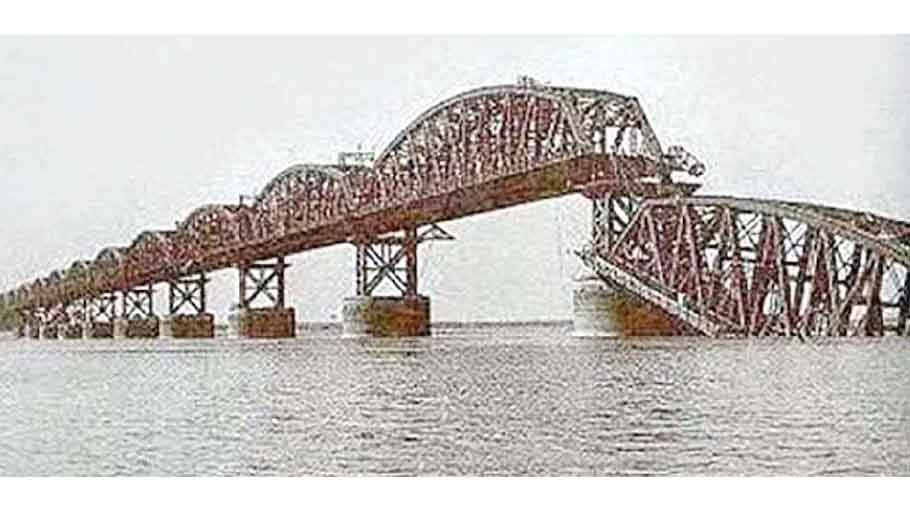Ishwardi Free Day today, FF bombed Hardinge Bridge to halt Pak army movement

Two days before the victory of Bangladesh to be declared, accepting the defeat, the Pakistani army started surrendering in different areas of the country. Just two days before the victory of the Great War of Liberation, on December 14, Pakistan's largest railway bridge at Pakshi in Ishwardi, Pabna, was bombed and a span of the bridge was destroyed to obstruct the movement of Pakistani troops. A part of that bomb still bears the memory of the liberation war. The remains of the bomb is stored in front of the office of Divisional Manager (DRM) of Railway Pakshi. Visitors from different parts of the country come to Pakshi to see the bombshell that destroyed the bridge. The bombshell is now a reminder to the new generation of the liberation war devastation of the area.
Muktijoddha Company Commander Kazi Sadrul Haque Sudha said in his narration that the Pakistani soldiers were fleeing from Jashore, Kushtia and coming towards Ishwardi through Pakshi Hardinge Bridge. After receiving the news, the freedom fighters took a position on the road at Charsahapur to face the Pak forces. Jashore-Kushtia was liberated then. The Pak invaders started crossing the Hardinge Bridge in groups. They seemed to be quite hungry. At that time, when the freedom fighters called for surrender on the side of Ishwardi Kushtia Road, the Pak Army kept firing without heeding. When the freedom fighters also fired back, the Pak forces started attacking the freedom fighters. At one point, the freedom fighters organized and surrounded the Pak Army around the village. Pak army became reckless. They crossed the Hardinge Bridge with tanks, artillery and jeeps. Sadrul Haque Sudha said, in this situation, we want the cooperation of the air force through wireless to the local commander of the allied forces. Around 12 noon, five Indian fighter jets circled the Hardinge Bridge over Pakshi. Then the bombardment from the planes started. Four or five bombs were dropped on Hardinge Bridge. Due to the heavy impact of the bomb, one side of the twelve span of the bridge broke and fell into the Padma River. Another span suffers severe damage. Suddenly the sound of the bomb startled the freedom fighters. And the Pak army broke the ambush and started fleeing from Pakshi.
Freedom fighter and cultural organizer Professor Abul Kalam Azad, a resident of Pakshi, said, "We were then stationed near Pakshi Paper Mill Baggage Yard in Bagheil village.
Around 12:00 PM, the Indian allied planes were practicing in the sky for a long time. At first there was a loud sound of bomb explosions from three planes and after a while from another plane. The ground shook at the sound. After the sound, the area was covered with heavy dust and smoke. Later we went and saw that the western part of span number 12 of the bridge was under water. Another bomb that day was thrown into the sandbar to the west of the bridge, about fifty yards from the Pakshi railway station platform. Another bomb fell on the railway line. A bomb dropped from an airplane fell on the sand and did not explode. Later, with the help of the army, an explosion was made inside the sand. The opening of that bomb is kept in front of Pakshi Railway Divisional Manager's office.
Local elders said that when Ishwardi was freed on December 16, the 12th span was seen lying in the water lying on one side at the destroyed Hardinge Bridge. The dead bodies of the Pak Army are hanging from the power cables attached to the bridge. A tank left by the Pak Army was lying on the bridge at that time. Pak forces could not cross the bridge as it was broken. Later, new spans were installed at Hardinge Bridge.
It was found that the shell of the bomb is kept under security in front of Pakshi DRM office. A railway employee said that the iron shell weighed about two mounds. The bomb shell is painted and cemented. It is surrounded by iron. Many visitors come here to see the Liberation War memorial bomb shell. The bomb shell is regularly cleaned, preserved and painted by Pakshi Railway Engineering Department.


